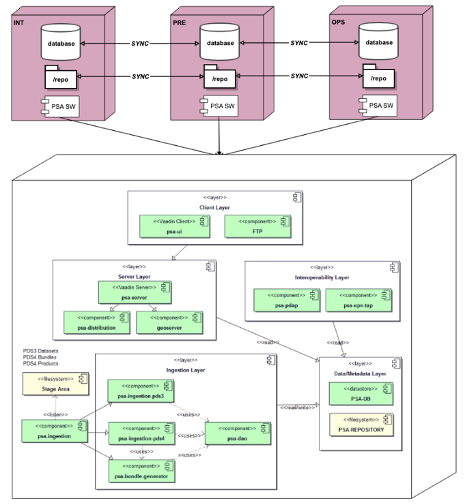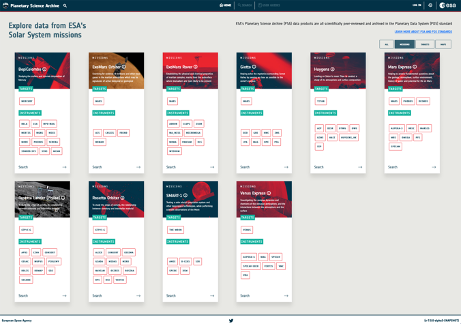ESA’s Planetary Science Archive: present and future
- 1Aurora Technology BV for ESA, Camino Bajo del Castillo s/n, 28692 Villanueva de la Cañada, Madrid, Spain
- 2Rhea for ESA, Camino Bajo del Castillo s/n, 28692 Villanueva de la Cañada, Madrid, Spain
- 3ESA/ESAC, Camino Bajo del Castillo s/n, 28692 Villanueva de la Cañada, Madrid, Spain
- 4Telespazio UK Ltd for ESA, Camino Bajo del Castillo s/n, 28692 Villanueva de la Cañada, Madrid, Spain
- 5Serco for ESA, Camino Bajo del Castillo s/n, 28692 Villanueva de la Cañada, Madrid, Spain
Introduction: The present abstract is intended to show the current ESA’s Planetary Science Archive (PSA) [1] in terms of architecture/infrastructure and the future interfaces and technologies which will be used in the next generation archive.
These improvements range from a new graphical user interface developed in Angular to a TAP+ (Table Access Protocol) service as a single access to the data, through a new way of releasing new versions of the PSA more frequently to the scientific community.
The PSA development team expects to release this new generation of the PSA this summer 2022.
PSA current architecture: The PSA architecture and the technologies involved in its development have only undergone incremental updates in the last 6 years, and are now seen as somewhat obsolete. The front-end has been implemented using the Vaadin framework, which was initially a good strategy, but over time became onerous to maintain (e.g., dealing with JavaScript libraries, wasting time in wrapping some required extensions in Java).
Also, from the back-end point of view, there are many interfaces/libraries to access the database (JDBC, PDAP, Data Distribution, etc) forcing us to double the effort when changing the API (see Figure 1: PSA current architecture)
In addition, the PSA release approach has not followed a truly Agile approach, taking too long in releasing operationally. This is mainly due to the fact there is no a fully CI/CD strategy to be executed in the environments, leading to very manual release process with manual interventions. Also there are additional problems such as the synchronisation of the repositories when releasing, which strongly depends on the IT department.

Figure 1: PSA current architecture
New interfaces, technologies and infrastructure at PSA: After one year and half of development, the PSA development team has been able to achieve several goals on the roadmap to a new archive. Mainly, we will rely on a new graphical user interface implemented under the Angular framework (see Figure 2: Future PSA Graphical User Interface). There have been various reasons to migrate to this new technology: Faster development for maps visualisation and 3D interfaces, alignment within the ESDC department in a common front-end framework and also, the discontinuation of Vaadin 8 from March 2022 on.
This future GUI will have a modern look and feel, with some relevant changes in line with the new ESA branding. Specially on the home view, where there are now card layouts to access the data from missions/instruments, targets and maps and a prototype traverse view for the ExoMars Rover mission, among other features. This new Angular framework has definitely sped the development up when modifying some JavaScript libraries, creating some end-to-end tests on top through Cypress, etc. This will also increase the performance on the client side consequently improving the user experience. In addition, this implementation is also mobile and tablet friendly/responsive.

Figure 2: Future PSA Graphical User Interface
Also, the new PSA will count on a single access point to the data through TAP+ (even private data) to homogenise the access by offering a single API, instead of using different interfaces/protocols (JDBC, PDAP, etc.) to access the information.
In addition to these new interfaces, the PSA is making a huge effort to set up an infrastructure to support a faster deployment cycle in order to be more agile according to the scrum methodology. This implies integrating and deploying the software (after checking metrics in Sonar, passing the end-to-end tests, etc.) as nightly builds into a safe environment (pre-production) so that the Archive Scientists can test the latest features which, once approved, will go to the operational environment. This follows mostly a DEV-OPS infinite loop but having a middle environment (PRE) in which the scientists can safely test the features.
Conclusion: The current PSA development team along with the Science Lead and all of the Archive Scientists are working together to produce a new generation of the planetary archive, with these features:
- a more modern and responsive GUI based on a stable and well-known technology
- a single access route to the data with authentication and authorization for private products (TAP+)
- a new infrastructure of environments which allow a more efficient CI/CD so that the features can be validated earlier, allowing the PSA to offer releases in the operational environment more frequently.
References:
[1] Besse, S. et al. (2017) Planetary and Space Science, 10.1016/j.pss.2017.07.013, ESA's Planetary Science Archive: Preserve and present reliable scientific data sets.
Acknowledgments: The authors would like to thank everybody, especially the PSA development team, who have contributed to the development of the PSA in the recent years and the incoming new generation of the archive.
How to cite: Docasal, R., Felix-Redondo, F., Oliveira, J., Osinde, J., Raga, F., Saiz, J., Valles, R., Merin, B., Bentley, M., Coia, D., Grotheer, E., Heather, D., and Lim, T.: ESA’s Planetary Science Archive: present and future , Europlanet Science Congress 2022, Granada, Spain, 18–23 Sep 2022, EPSC2022-127, https://doi.org/10.5194/epsc2022-127, 2022.

